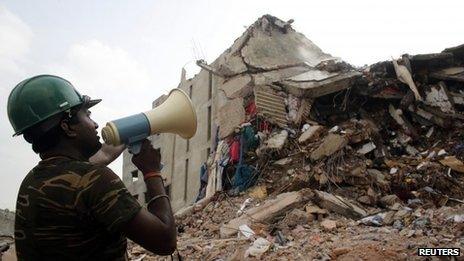Bangladesh factory collapse probe uncovers abuses
- Published

One day before the collapse, the building was briefly evacuated when cracks appeared in the walls
A Bangladesh government report into the collapse of a multi-storey factory building, which killed more than 1,100, has uncovered a series of violations.
The report said the building had been constructed with sub-standard materials on unsuitable land.
It also recommended life sentences for the building's owner and the owners of five garment factories operating there.
The Rana Plaza collapse on 24 April is one of the world's worst industrial disasters and sparked global outrage.
It highlighted working conditions, low wages and safety standards in the country's garment sector. In the wake of the disaster, there have been a series of angry protests by workers in the garment industry.
On Thursday, thousands of garment workers took to the streets in Ashulia, the industrial belt near Dhaka, demanding wage increases and other benefits. Some vehicles were attacked during the protest.
The Bangladesh Garment Manufactures and Exporters Association (BGMEA) said they had shut down 21 factories to avoid further unrest.
'Poor construction'
The Rana Plaza disaster prompted the government to introduce some reforms and some international retailers have also proposed an accord to improve safety conditions in Bangladesh.
The owner of the building, Mohammad Sohel Rana, was arrested last month as were the owners of factories inside the building.
Mr Rana has made no public comment about the incident. His father and uncle have also been arrested and no members of his family have come forward with a statement.
The man in charge of the investigation, Mainuddin Khandker, told BBC Bangla on Wednesday that "extremely poor" construction materials were used in the building and said the report identified five causes of the collapse.
"A portion of the building was also constructed on land which had been a body of water before and was filled with rubbish," he told the Associated Press news agency.
The 400-page report was submitted to the government on Wednesday. It also made several recommendations. As well as life sentences for those responsible for the collapse these included:
Confiscating the land on which the factory had been built
Providing financial support to the families of the workers who died and who were injured
Forming a department specifically to deal with this sector of the garment industry to prevent a repeat of such incidents
The authorities say 1130 people died, about 2,500 people were injured in the accident and 2,437 people were rescued.
On 10 May a woman was pulled alive from the rubble, 17 days after the collapse. It was a glimmer of hope for rescue workers after weeks of hauling bodies out of the ruins but the authorities called off the rescue just three days later.
Just a day before the collapse, the building was briefly evacuated when cracks appeared in the walls. However, workers were later allowed back in or told to return by the factory owners.
Bangladesh has one of the largest garment industries in the world. Some of the clothes produced in the Rana Plaza building were made for Western retailers.
*Reports say New Wave Style supplied up to 27 companies from its Dhaka factories, but the full list is not available.